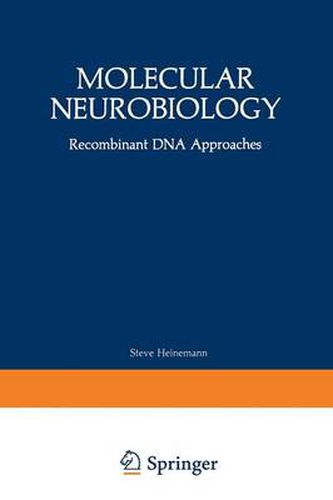Readings Newsletter
Become a Readings Member to make your shopping experience even easier.
Sign in or sign up for free!
You’re not far away from qualifying for FREE standard shipping within Australia
You’ve qualified for FREE standard shipping within Australia
The cart is loading…






This title is printed to order. This book may have been self-published. If so, we cannot guarantee the quality of the content. In the main most books will have gone through the editing process however some may not. We therefore suggest that you be aware of this before ordering this book. If in doubt check either the author or publisher’s details as we are unable to accept any returns unless they are faulty. Please contact us if you have any questions.
This book is a collection of papers describing some of the first attempts to apply the techniques of recombinant DNA and molecular biology to studies of the nervous system. We believe this is an important new direction for brain research that will eventually lead to insights not pos sible with more traditional approaches. At first glance, the marriage of molecular biology to brain research seems an unlikely one because of the tremendous disparity in the histories of these two disciplines and the problems they face. Molecular biology is by nature a reductionist approach to biology. Molecular biologists have always tried to attack central questions in the most direct approach possible, usually in the most simple system available: a bacterium or a bacterial virus. Important experiments can usually be repeated quickly and cheaply, in many cases by the latest group of graduate students entering the field. The success of molecular biology has been so profound because the result of each important experiment has made the next critical question obvious, and usually answerable, in short order. Studies of the nervous system have a very different history. First, the human brain is what really interests us and it is the most complex structure that we know in biology. The central question is clear: How do we carry out higher functions such as learning and thinking? How ever, at present there is no widely accepted and testable theory of learn ing and no clear path to such a theory.
$9.00 standard shipping within Australia
FREE standard shipping within Australia for orders over $100.00
Express & International shipping calculated at checkout
This title is printed to order. This book may have been self-published. If so, we cannot guarantee the quality of the content. In the main most books will have gone through the editing process however some may not. We therefore suggest that you be aware of this before ordering this book. If in doubt check either the author or publisher’s details as we are unable to accept any returns unless they are faulty. Please contact us if you have any questions.
This book is a collection of papers describing some of the first attempts to apply the techniques of recombinant DNA and molecular biology to studies of the nervous system. We believe this is an important new direction for brain research that will eventually lead to insights not pos sible with more traditional approaches. At first glance, the marriage of molecular biology to brain research seems an unlikely one because of the tremendous disparity in the histories of these two disciplines and the problems they face. Molecular biology is by nature a reductionist approach to biology. Molecular biologists have always tried to attack central questions in the most direct approach possible, usually in the most simple system available: a bacterium or a bacterial virus. Important experiments can usually be repeated quickly and cheaply, in many cases by the latest group of graduate students entering the field. The success of molecular biology has been so profound because the result of each important experiment has made the next critical question obvious, and usually answerable, in short order. Studies of the nervous system have a very different history. First, the human brain is what really interests us and it is the most complex structure that we know in biology. The central question is clear: How do we carry out higher functions such as learning and thinking? How ever, at present there is no widely accepted and testable theory of learn ing and no clear path to such a theory.